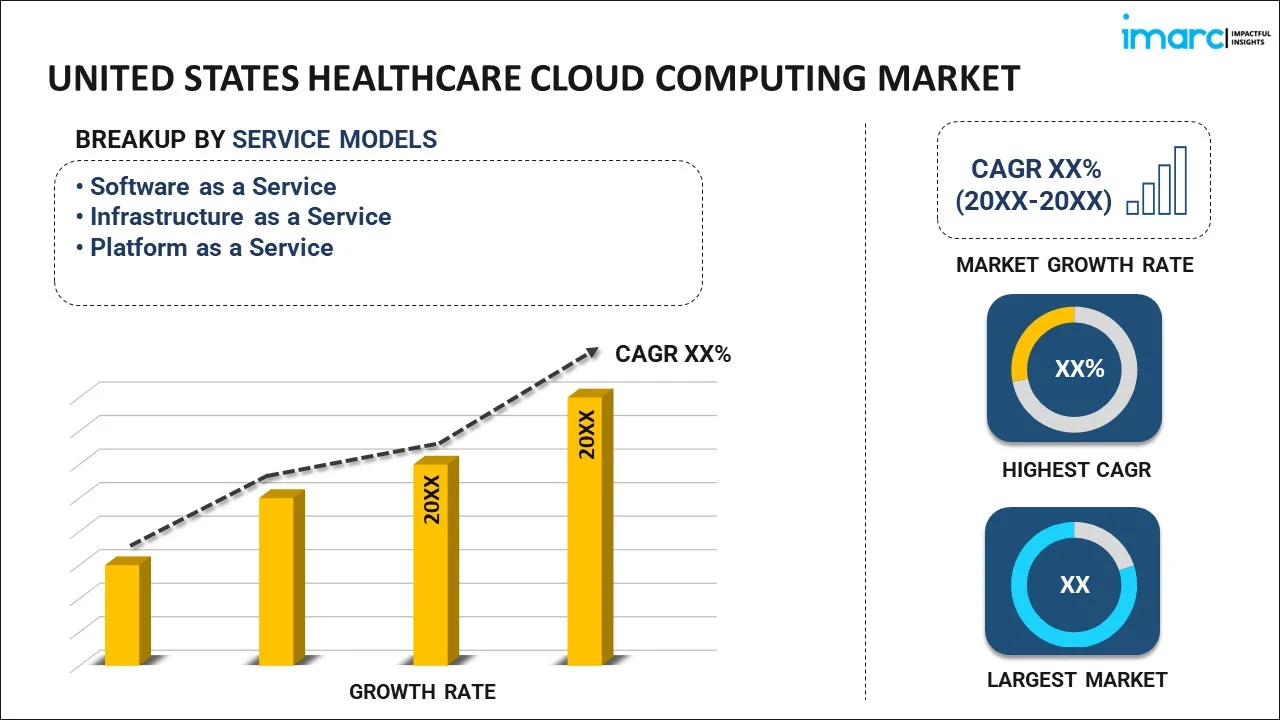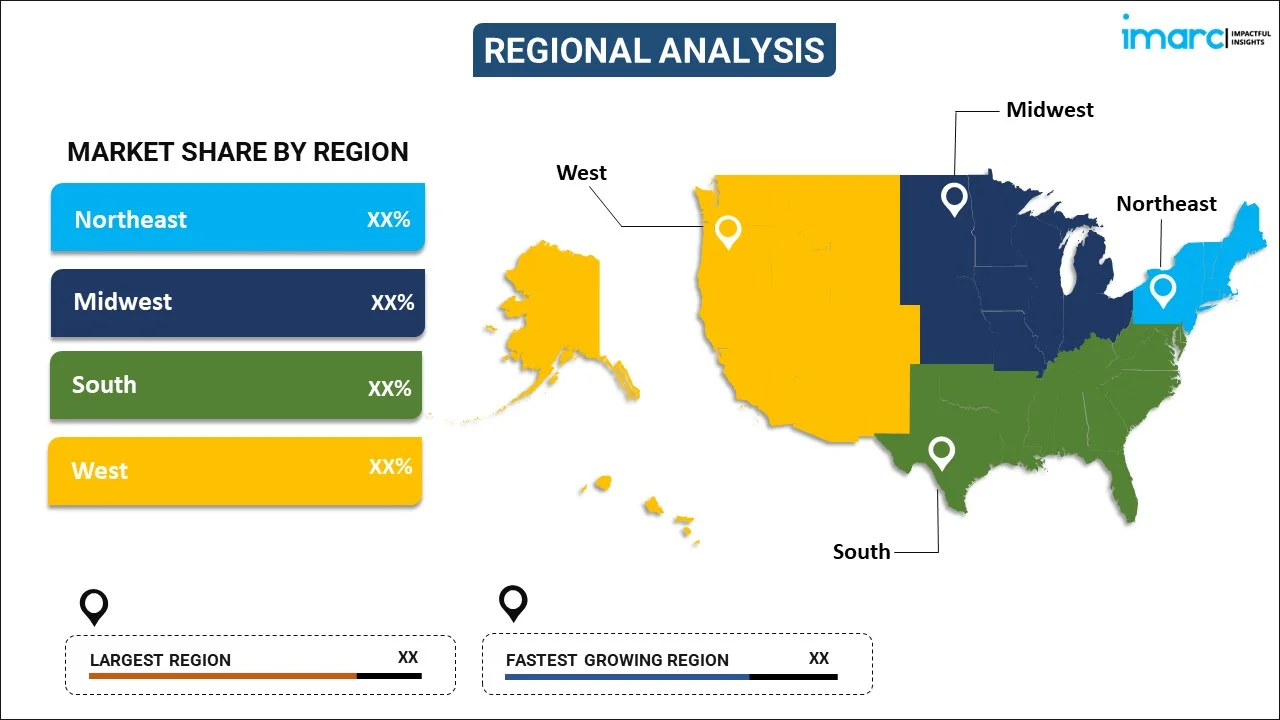
United States Healthcare Cloud Computing Market Report by Service Model (Software as a Service, Infrastructure as a Service, Platform as a Service), Cloud Deployment Model (Private Cloud, Public Cloud, Hybrid Cloud), Application (Clinical Information System, Non-Clinical Information System), End User (Healthcare Providers, Healthcare Payers), and Region 2025-2033
Market Overview:
The United States healthcare cloud computing market size reached USD 12 Billion in 2024. Looking forward, IMARC Group expects the market to reach USD 34.4 Billion by 2033, exhibiting a growth rate (CAGR) of 12.1% during 2025-2033. The increasing shift toward electronic health records (EHRs), telemedicine, and data-driven decision-making, the rising amounts of data, including patient records, and the escalating demand for interoperability and seamless data sharing among healthcare providers represent some of the key factors driving the market.
|
Report Attribute
|
Key Statistics
|
|---|---|
|
Base Year
|
2024 |
|
Forecast Years
|
2025-2033
|
|
Historical Years
|
2019-2024
|
| Market Size in 2024 | USD 12 Billion |
| Market Forecast in 2033 | USD 34.4 Billion |
| Market Growth Rate (2025-2033) | 12.1% |
Healthcare cloud computing refers to the use of cloud computing technologies and services in the healthcare industry to store, manage, and access healthcare data and applications over the internet. It involves the migration of various healthcare-related processes, systems, and data to cloud-based platforms, allowing healthcare providers, organizations, and professionals to benefit from the flexibility, scalability, and cost-efficiency offered by cloud technology. Cloud computing supports HIE platforms that allow different healthcare facilities and providers to share patient data securely. This promotes interoperability and enhances patient care by providing a comprehensive view of a patient's medical history. Besides, cloud-based telemedicine platforms enable remote consultations, virtual visits, and remote patient monitoring. Patients can connect with healthcare providers from their homes, reducing the need for in-person visits and expanding access to care. These platforms also facilitate the integration of emerging technologies like artificial intelligence (AI), machine learning, and Internet of Things (IoT) into healthcare applications and services.
United States Healthcare Cloud Computing Market Trends:
The healthcare sector is undergoing a digital transformation, with a shift toward electronic health records (EHRs), telemedicine, and data-driven decision-making. Cloud computing provides the necessary infrastructure and scalability to support these initiatives, making it a fundamental driver of the market's growth. In addition, healthcare organizations are under pressure to control costs while delivering high-quality care. Cloud computing offers cost-effective solutions by eliminating the need for extensive on-premises hardware and reducing maintenance expenses. This cost containment is particularly attractive to healthcare providers. Besides, healthcare generates vast amounts of data, including patient records, medical images, and genomic information. Cloud solutions enable secure and scalable storage, management, and analysis of this data, facilitating research, diagnostics, and personalized medicine. Moreover, the push for interoperability and seamless data sharing among healthcare providers, payers, and patients is a key driver. Cloud-based health information exchanges (HIEs) and EHR systems make it easier to share patient data securely, improving care coordination and patient outcomes. Furthermore, the rapid adoption of telemedicine and remote patient monitoring, especially in response to the COVID-19 pandemic, relies on cloud infrastructure. Cloud-based telehealth platforms enable secure, real-time video consultations and remote monitoring of patients, expanding access to care. Additionally, the healthcare industry is subject to strict regulatory requirements, such as the Health Insurance Portability and Accountability Act (HIPAA). Cloud providers offer compliance certifications and robust security measures to ensure that healthcare data remains secure and meets regulatory standards. On account of these factors, the market is expected to witness positive growth in the coming years.
United States Healthcare Cloud Computing Market Segmentation:
IMARC Group provides an analysis of the key trends in each segment of the market, along with forecasts at the country level for 2025-2033. Our report has categorized the market based on service model, cloud deployment model, application, and end user.
Service Model Insights:

- Software as a Service
- Infrastructure as a Service
- Platform as a Service
The report has provided a detailed breakup and analysis of the market based on the service model. This includes software as a service, infrastructure as a service, and platform as a service.
Cloud Deployment Model Insights:
- Private Cloud
- Public Cloud
- Hybrid Cloud
A detailed breakup and analysis of the market based on the cloud deployment model have also been provided in the report. This includes private cloud, public cloud, and hybrid cloud.
Application Insights:
- Clinical Information System
- Computerized Physician Order Entry
- Electronic Medical Records
- Radiology Information System
- Pharmacy Information System
- Others
- Non-clinical Information System
- Automatic Patient Billing
- Revenue Cycle Management
- Claims Management
- Others
The report has provided a detailed breakup and analysis of the market based on the application. This includes clinical information system (computerized physician order entry, electronic medical records, radiology information system, pharmacy information system, and others) and non-clinical information system (automatic patient billing, revenue cycle management, claims management, and others).
End User Insights:
- Healthcare Providers
- Healthcare Payers
A detailed breakup and analysis of the market based on the end user have also been provided in the report. This includes healthcare providers and healthcare payers.
Regional Insights:

- Northeast
- Midwest
- South
- West
The report has also provided a comprehensive analysis of all the major regional markets, which include Northeast, Midwest, South, and West.
Competitive Landscape:
The market research report has also provided a comprehensive analysis of the competitive landscape. Competitive analysis such as market structure, key player positioning, top winning strategies, competitive dashboard, and company evaluation quadrant has been covered in the report. Also, detailed profiles of all major companies have been provided.
United States Healthcare Cloud Computing Market Report Coverage:
| Report Features | Details |
|---|---|
| Base Year of the Analysis | 2024 |
| Historical Period | 2019-2024 |
| Forecast Period | 2025-2033 |
| Units | Billion USD |
| Scope of the Report | Exploration of Historical and Forecast Trends, Industry Catalysts and Challenges, Segment-Wise Historical and Predictive Market Assessment:
|
| Service Models Covered | Software as a Service, Infrastructure as a Service, Platform as a Service |
| Cloud Deployment Models Covered | Private Cloud, Public Cloud, Hybrid Cloud |
| Applications Covered |
|
| End Users Covered | Healthcare Providers, Healthcare Payers |
| Regions Covered | Northeast, Midwest, South, West |
| Customization Scope | 10% Free Customization |
| Post-Sale Analyst Support | 10-12 Weeks |
| Delivery Format | PDF and Excel through Email (We can also provide the editable version of the report in PPT/Word format on special request) |
Key Questions Answered in This Report:
- How has the United States healthcare cloud computing market performed so far and how will it perform in the coming years?
- What has been the impact of COVID-19 on the United States healthcare cloud computing market?
- What is the breakup of the United States healthcare cloud computing market on the basis of service model?
- What is the breakup of the United States healthcare cloud computing market on the basis of cloud deployment model?
- What is the breakup of the United States healthcare cloud computing market on the basis of application?
- What is the breakup of the United States healthcare cloud computing market on the basis of end user?
- What are the various stages in the value chain of the United States healthcare cloud computing market?
- What are the key driving factors and challenges in the United States healthcare cloud computing?
- What is the structure of the United States healthcare cloud computing market and who are the key players?
- What is the degree of competition in the United States healthcare cloud computing market?
Key Benefits for Stakeholders:
- IMARC’s industry report offers a comprehensive quantitative analysis of various market segments, historical and current market trends, market forecasts, and dynamics of the United States healthcare cloud computing market from 2019-2033.
- The research report provides the latest information on the market drivers, challenges, and opportunities in the United States healthcare cloud computing market.
- Porter's five forces analysis assist stakeholders in assessing the impact of new entrants, competitive rivalry, supplier power, buyer power, and the threat of substitution. It helps stakeholders to analyze the level of competition within the United States healthcare cloud computing industry and its attractiveness.
- Competitive landscape allows stakeholders to understand their competitive environment and provides an insight into the current positions of key players in the market.
Need more help?
- Speak to our experienced analysts for insights on the current market scenarios.
- Include additional segments and countries to customize the report as per your requirement.
- Gain an unparalleled competitive advantage in your domain by understanding how to utilize the report and positively impacting your operations and revenue.
- For further assistance, please connect with our analysts.
 Inquire Before Buying
Inquire Before Buying
 Speak to an Analyst
Speak to an Analyst
 Request Brochure
Request Brochure
 Request Customization
Request Customization




.webp)




.webp)












